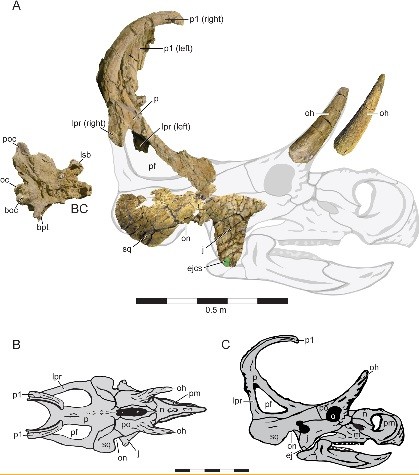New Horned Dinosaur Discovered in Utah
| Ana Verayo | | May 20, 2016 06:41 AM EDT |
(Photo : Eric K. Lund Patrick M. O’Connor Mark A. Loewen Zubair A. Jinnah) Holotype cranial Material and Cranial Reconstruction of Machairoceratops cronusi
Scientists uncovered a new dinosaur species that was in Utah, that has never been seen before.
A team of researchers that have been working at the Grand Staircase-Escalante National Monument has identified that this new dinosaur species is this large, herbivorous animal that also possesses horns, is also estimated to measure from 19 to 26 feet long and could possibly weigh close to two tons.
Like Us on Facebook
After three field excavation seasons, the team finally extracted the dinosaur fossils buried deep in the ground.This dinosaur is now officially named as Machairoceratops cronusi that thrived during a time where dinosaurs ruled the Earth, some 77 million years ago, during the Late Cretaceous period. However, scientists say that this kind of dinosaur is quite rare to be seen in this region especially in the United States, as their fossilized remains are usually recovered in areas like Montana and Alaska.
According to co-author of the study, Patrick O'Connor from Ohio University, in western parts of North America, where most excavations and field research are being carried out, it still proves to be a rich region filled with new species that are waiting to be discovered.
This ancient creature was living during the Cretaceous Period in a region located in North America that scientists have called Laramidia, which is a western part of land that was divided by a sea in between the continent. This new dinosaur was uncovered in the southern area of Laramidia, where dinosaurs belonging to the same family and group were also discovered in the northern part of Laramidia. Scientists suggest that these dinosaurs lived in two habitats in two different regions, making up two sub-groups that adapted through evolution.
These dinosaurs are known as Centrosaurine ceratopsids where they possessed horns and beaks along with neck shields. According to lead author of the study, Erik Lund from Ohio University, the Machairoceratops is considered to be unique as it possesses two large spikes that are curving to the back of their neck shield, where each is marked with a strange groove beginning from the base of the spike across its tips, however, its main function is still a mystery.
This new study is published in the journal PLOS ONE.
Tagsnew dinosaur species, horned dinosaur, Utah, Dinosaurs, Cretaceous period, machairoceratops
©2015 Chinatopix All rights reserved. Do not reproduce without permission
EDITOR'S PICKS
-

Did the Trump administration just announce plans for a trade war with ‘hostile’ China and Russia?
-

US Senate passes Taiwan travel bill slammed by China
-

As Yan Sihong’s family grieves, here are other Chinese students who went missing abroad. Some have never been found
-

Beijing blasts Western critics who ‘smear China’ with the term sharp power
-

China Envoy Seeks to Defuse Tensions With U.S. as a Trade War Brews
-

Singapore's Deputy PM Provides Bitcoin Vote of Confidence Amid China's Blanket Bans
-

China warns investors over risks in overseas virtual currency trading
-

Chinese government most trustworthy: survey
-

Kashima Antlers On Course For Back-To-Back Titles
MOST POPULAR
LATEST NEWS
Zhou Yongkang: China's Former Security Chief Sentenced to Life in Prison

China's former Chief of the Ministry of Public Security, Zhou Yongkang, has been given a life sentence after he was found guilty of abusing his office, bribery and deliberately ... Full Article
TRENDING STORY

China Pork Prices Expected to Stabilize As The Supplies Recover

Elephone P9000 Smartphone is now on Sale on Amazon India

There's a Big Chance Cliffhangers Won't Still Be Resolved When Grey's Anatomy Season 13 Returns

Supreme Court Ruled on Samsung vs Apple Dispute for Patent Infringement

Microsoft Surface Pro 5 Rumors and Release Date: What is the Latest?










